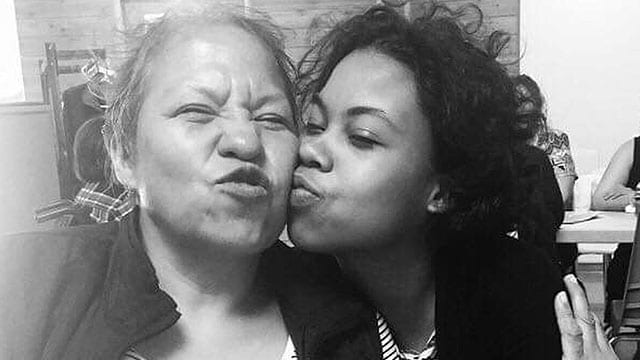Less than a year ago Judith Paul was facing homelessness.
Child and family services had provided care for Paul for the past 14 years, but that day it all ended when her social worker handed her a form for a Winnipeg homeless shelter.
Paul had aged out.
“I felt a little bit abandoned. Just kind of like a slap in the face. Like it’s up to me to take care of myself like I’m my own parent,” said Paul.
“The government doesn’t really care.”
The form was an application for a youth housing program run through Siloam Mission.
(Judith with Donna, her birthmother. Photo courtesy Judith Paul)
In Manitoba, youth age out of care at the age of 18 but can make a request to extend services until the age of 21.
Paul was 19 at the time and still in high school.
She had her care extended by a year and that was about to run out when she filled out that form her social worker handed her to the Siloam Mission.
She said at one point she accepted the option so she began to fill out the application.
“I didn’t even think that it was not okay until other people told me,” said Paul.
Paul believed every person leaving care received this form.
Paul is Ojibway and Jamaican. Her mother is from Northwest Angle 33 First Nation near Kenora, ON.
The now 20-year-old is soft-spoken but insightful.
Paul’s maternal grandmother attended the residential school system, she said.
The trauma her grandmother experienced was passed down to Paul’s mother. Paul said it got to a point where her mother could no longer care for her and her siblings.
Born and raised in Winnipeg, Paul was apprehended when she was five-years-old.
She spent 10 years in a foster home before she moved at the age of 15 into a group home.
“I was in a group home in the North End and I guess I was just expecting the people around me to show me how to find an apartment and get on [social assistance] for support,” said Paul. “It was really hard for the staff to show me how to do that for myself so I moved in with my sister. She showed me a lot.
“Things that I thought my social worker would teach me for those four years my sister taught me in three months.”
(Judith, right, with her sisters Jasmine Paul, left and Shannon Paul. Photo courtesy: Judith Paul)
Paul relied on siblings and friends for temporary shelter.
That is until Lorie Thompson entered her life and offered her a place to stay.
Thompson heard about Paul’s situation from a relative last fall.
“When I saw what she looked like I just felt fear. Fear because she’s so small but yet she’s got to manage out there on her own,” said Thompson from her home she now shares with Paul.
Over the past 20 years, Thompson has opened her home to more than 100 youth aging out of care.
She calls the practice of referring youth to homeless shelters criminal.
“This is just a recipe for disaster. Sending a young woman or any young person into that type of living and expecting them to survive and make something of it,” she said.
In Thompson’s experience the system doesn’t help prepare youth to live on their own.
In 2018, 674 youth aged out of care in Manitoba, according to statistics provided to APTN News from the province.
Of those, 507 were Indigenous.
These statistics do include youth who had their care extended beyond 18. They account for 322 of the 674.
Recent statistics show former youth in care make up approximately half of the homeless population in Winnipeg.
According to last year’s Winnipeg Street Census report, 51 per cent of people experiencing homelessness had been in care at one point in their life and 62 per cent of those experienced homelessness within one year of leaving care.
“It makes me really sad knowing that this is the prospect of our future generations,” said Thompson.
“We should be building them up and empowering them to have the biggest dreams that they can have.”
(Judith smudging with Lorie Thompson. Photo courtesy Judith Paul)
A spokesperson for the government of Manitoba told APTN social workers and youth in care are supposed to work together to create a plan to help transition the youth safely out of care.
This would not include a planned move to a homeless shelter but the province admitted this sometimes happens as a last resort.
“If a young person does not wish to engage with their CFS (child and family services) agency to develop a housing plan or follow through to access services, the agency may provide information about emergency resources.”
As Paul talks about her time in care it’s clear she’s still processing the experience.
She recalls moments of feeling helpless after being bounced around five different group homes.
“[It] just kind of felt like I was existing. They didn’t know where to put me,” she said.
Paul relies on ceremonies to keep her grounded. It’s something she shares with Thompson who she now calls ‘aunty.’
Since aging out Paul has been able to reconnect with her birth mother for the first time since being apprehended.
She hopes to graduate high school this year, and then university.
“For me, I want to become more of an advocate. I wouldn’t mind working in those group homes with the girls.”













